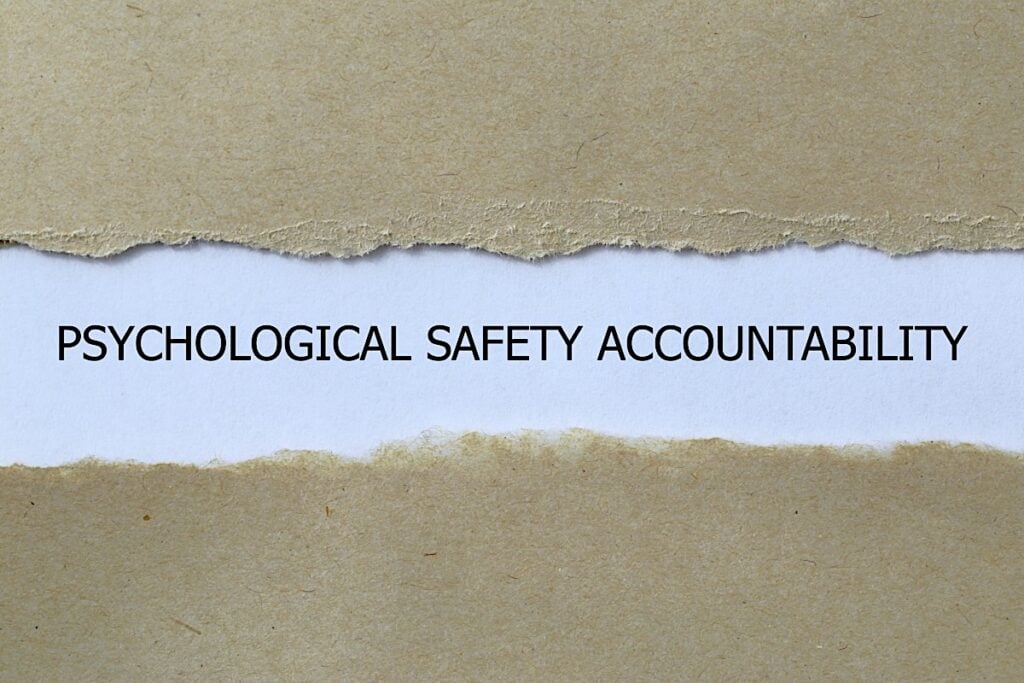
Understanding Psychological Safety the Six Steps to Implementing It for HR Managers
Psychological safety can be described as the belief that you won’t be punished or humiliated for speaking up with ideas, questions, concerns, or mistakes. In a workplace environment, this translates to a culture where you feel confident sharing your perspectives without fear of negative consequences. So, why is this crucial for companies, particularly in Canada?

When employees feel psychologically safe, they are more likely to engage, contribute innovative ideas, and collaborate effectively. This isn’t just a feel-good factor; it’s a tangible asset that can lead to better problem-solving and increased productivity.
“The key to a company’s performance is not strategies, processes, and systems, but the people who make these strategies, processes, and systems work,” says Amy Edmondson, Professor of Leadership at Harvard Business School and a renowned expert in psychological safety.
Quick Facts
- Psychological safety is the belief that one will not be punished or humiliated for speaking up with ideas, questions, concerns, or mistakes
- High levels of psychological safety in the workplace are linked to increased employee engagement and productivity
- Psychological safety is a critical factor in effective team collaboration
- Lack of psychological safety can lead to increased employee stress and turnover (Harvard Business Review)
- Creating a psychologically safe environment requires leadership commitment and consistent communication (Center for Creative Leadership)
- Psychological safety supports mental health and well-being in the workplace
- Employees in psychologically safe environments are more likely to report errors and near misses, leading to improved organizational learning
- Canadian companies are increasingly recognizing the importance of psychological safety in HR management
Psychological Safety and Canadian HR Management
Canadian companies, known for their diverse and inclusive work environments, can significantly benefit from integrating psychological safety into their HR management strategies. Here are a few compelling reasons:
- Enhanced Team Performance: Teams are more likely to take risks and explore creative solutions when they feel safe.
- Employee Well-being: A psychologically safe environment contributes to reduced stress and better mental health.
- Retention and Recruitment: Companies that prioritize psychological safety are more attractive to potential hires and retain their current talent.
- Innovation: Encouraging a culture where all ideas are welcome fosters innovation and keeps the company competitive.
By making psychological safety a cornerstone of HR management, Canadian companies can unlock a wealth of potential benefits, positioning themselves as leaders in both employee satisfaction and business performance.

Quick Statistics
- Employees in psychologically safe environments are 27% more likely to report job satisfaction
- Companies with strong psychological safety practices see a 15% increase in employee retention
- Psychological safety can lead to a 35% reduction in workplace errors
- Organizations with high psychological safety report a 20% increase in innovation
- Psychologically safe teams are 50% more likely to collaborate effectively
- Employees who feel psychologically safe are 31% more likely to speak up with new ideas
- Workplaces that prioritize psychological safety see a 25% decrease in employee stress levels
Why Psychological Safety Matters in HR Management
For Canadian companies, incorporating psychological safety into HR management isn’t merely a trendy concept—it’s a necessity. With a competitive market and an evolving workforce, organizations that fail to prioritize employee well-being are likely to struggle with retention and productivity.
Research underscores that psychological safety is a cornerstone of high-performing teams. In environments where psychological safety is a priority, teams exhibit higher levels of creativity, engagement, and productivity. This isn’t anecdotal; studies have consistently shown a direct correlation between psychological safety and various positive workplace outcomes, including innovation and sustainable growth.
Psychological safety can transform the entire organizational culture. When employees feel safe, they are more likely to share knowledge and collaborate effectively, reducing inefficiencies and driving better results. This sense of security extends beyond individual performance, fostering a strong, cohesive team that can weather challenges and adapt quickly to change.
In terms of HR management, psychological safety translates into actionable strategies. From nurturing a supportive leadership culture to implementing policies that prioritize employee mental health, the ways to enhance psychological safety are diverse and impactful. For example, regular training programs, open-door policies, and anonymous feedback channels can help promote a psychologically safe environment.
According to a McKinsey survey, nearly 89 percent of employees consider psychological safety crucial. Thus, it’s clear that this isn’t just a “nice-to-have” feature but a foundational element for any forward-thinking organization.
Tips for Fostering Psychological Safety in Canadian Workplaces
- Nurture and Maintain People: Prioritize employee well-being and ensure they feel valued and supported. This can mitigate massive turnover events and cultivate a healthy work environment.
- Run Pulse Surveys: Regularly measure psychological safety within teams using pulse surveys. This provides valuable insights into employee experiences and helps identify areas for improvement.
- Encourage Open Communication: Create an environment where employees feel safe to voice their opinions, share ideas, and take risks without fear of negative consequences.
- Recognize and Celebrate Contributions: Acknowledge and appreciate each team member’s feedback.
- Provide Supportive Leadership: Ensure leaders and managers are approachable, empathetic, and supportive– and trained to understand Psychological Safety. Effective leadership plays a crucial role in fostering a psychologically safe workplace.
Training Leaders to Promote Psychological Safety
Implementing training programs that highlight the importance of psychological safety is crucial. Begin by educating leaders about what psychological safety is and its profound impact on team dynamics and overall company success.
1. Understanding Psychological Safety: Leaders must grasp the concept of psychological safety, recognizing it as the belief that one will not be humiliated or punished for speaking up with ideas, questions, or concerns. This understanding is foundational for any further action.
2. Promoting Open Communication: Encourage leaders to foster an environment where open communication is the norm. This might involve regular check-ins with team members, actively seeking their input during meetings, and creating channels for anonymous feedback.
3. Encouraging Risk-Taking: Leaders should create a culture where taking calculated risks is not only accepted but encouraged. Discussing past failures openly and what was learned from them can demystify risk-taking and emphasize its value in innovation.
4. Building Trust: Trust is the bedrock of psychological safety. Leaders can build trust by being transparent about their own challenges and by showing vulnerability. Acknowledging mistakes rather than covering them up fosters a team dynamic rooted in trust and mutual respect.
5. Providing Constructive Feedback: Instead of punitive measures, leaders should focus on constructive feedback. It’s about guiding team members to improve without instilling fear or reducing their self-worth. Regular training sessions on effective feedback methods can be very beneficial.
6. Measuring Psychological Safety: Utilize analytics to gauge the level of psychological safety within teams. Regular surveys and feedback mechanisms can identify areas needing improvement and track progress over time.
Investing in these training initiatives not only equips leaders with the knowledge and skills necessary to cultivate psychological safety but also signals to employees that the company values their well-being and development.
Creating Open Communication Channels
Open communication channels form the backbone of fostering psychological safety in Canadian workplaces. Imagine a team where everyone feels they can speak up without fear—whether it’s to present a bold new idea, voice a concern, or even just to disagree. That’s the environment you’re aiming for.
One effective strategy is to implement regular pulse surveys. These short, frequent surveys can help gauge how safe employees feel to express themselves. Companies like Google and Microsoft have successfully used these tools to measure psychological safety within their teams, and the results speak volumes.
It’s also essential to build trust and respect among team members. This starts at the leadership level. When leaders proactively seek input from everyone, champion transparency, and facilitate open forums for discussion, it sets a precedent for the entire team. It’s about walking the walk and not just talking the talk.
Don’t underestimate the power of inclusive communication. Initiatives like the Count Me In campaign and the Neuroinclusivity project have shown that empowering diverse voices can significantly enhance psychological safety. When everyone’s voice is valued, innovation thrives.
Lastly, encourage constructive disagreements. Cåonflicts are natural, and when handled respectfully, they can be incredibly productive. Teach your team to engage in healthy debates, see differing viewpoints as opportunities for growth, and always listen actively.
By creating robust communication channels, you’re not just nurturing psychological safety but also paving the way for a more innovative, inclusive, and dynamic workplace.
Do you have questions for our HR Management experts? Contact the experts at Pivotal:


 Our HR solutions experts can recommend the right mix of HR outsourced services to make your entry into Canada easier.
Our HR solutions experts can recommend the right mix of HR outsourced services to make your entry into Canada easier.  Pivotal Employment Management Services co-hires your workforce, simplifying entry of your business in Canada.
Pivotal Employment Management Services co-hires your workforce, simplifying entry of your business in Canada. 















